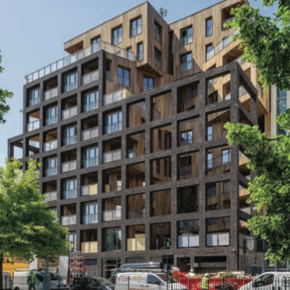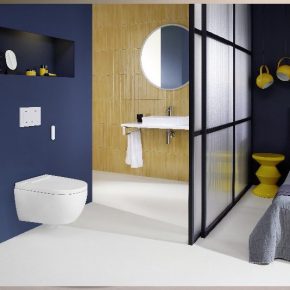
Optimised hybrid systems coming out on top
Timber has gone through a period of transformation and the latest developments are creating what the BBC has referred to as a timber revolution. Greg Cooper, preconstruction manager for B & K Structures, specialist in hybrid structural timber systems, offers some insight into the current global trend in the latest issue of ABC+D magazine.
From Canada and the USA to Australia and right here in the UK, architects and specifiers are realising the full capabilities of structural timber. Timber technology is becoming the vital component in shaping city skylines and this is happening on a global scale.
In the USA, a recent annual competition promoted wood as the building material for the next generation of architects, finding that the more building professionals learnt about the true nature of wood, the more they want to use it.
Australia has also embraced the trend through a change in building regulations allowing architects to design solid wood structures up to eight storeys in height for the first time and, as we enter this new era, terms such as tall timber have entered the construction vernacular.
What is behind this trend and why is timber technology gaining traction on a world-wide scale? Through the use of optimised hybrid timber solutions, contractors can transform traditional projects into more cost- effective, energy-efficient developments that, ultimately, have a positive impact on the environment and their bottom line.
By investing upfront in a robust, airtight building, operators and occupiers will see the long-term benefits that come from reduced maintenance and running costs – vital for public buildings such as schools and hospitals.
Residential, retail and commercial developers have their own prerequisites with an emphasis on speed of construction. Optimised hybrid timber structures offer a faster return on investment for developers, by delivering quick and efficient build processes for the retail and commercial sector, buildings become operational in the optimum time.
For cities such as London, with complex underground infrastructures, there is an important financial equation – lighter equals taller. Lighter weight timber systems reduce the impact on foundations so permitting additional storeys that would not be achievable using traditional materials such as masonry, concrete and steel.
This enables construction of up to ten storeys, with experts claiming that it could reach a whopping 33 storeys if developments in timber technology continue on this upward trajectory. Timber could play a massive role in tackling issues such as the current UK housing crisis by providing high volumes of quality, energy-efficient homes at a rapid rate.
The BBC recently reported that the construction industry is heading for a timber revolution and, as solutions and concepts are being developed by forward-thinking companies – new applications of timber technology are being conceived, such as building in the airspace above existing buildings.
As the concept is to build on top of existing buildings which are in operation – the success of this initiative is reliant on a quick and efficient method of construction.
As a lightweight, yet robust structural solution, manufactured off site in factories to exacting standards – engineered timber is a rapid form of construction which reduces the loading on foundations and is suitable for this application. However, the main benefit when compared to traditional construction, is the minimal disturbance to existing occupiers.
On-site works are undertaken methodically and quietly to minimise disturbance – a crucial requirement when constructing in the airspace above existing buildings.
We have an outstanding heritage in timber construction and, until now, the greatest period of timber building was centuries ago – fast forward over 300 years and we are now truly realising the full capabilities of this strong, sustainable and technically advanced structural solution.
Latest news

24th April 2024
Hamworthy Heating expands CIBSE approved CPD modules with new hot water series
Hamworthy Heating, technical experts in commercial heating and hot water products, announce the expansion of its market leading CIBSE approved Continuing Professional Development (CPD) portfolio with the launch of three new learning modules.
Posted in Articles, Building Industry Events, Building Industry News, Building Products & Structures, Building Services, Continuing Professional Development (CPD's), Facility Management & Building Services, Heating Systems, Controls and Management, Heating, Ventilation and Air Conditioning - HVAC, Plumbing, Retrofit & Renovation, Seminars, Training
24th April 2024
New technology partnership brings Passivent ventilation products to IESVE
Passivent has partnered with Integrated Environmental Solutions (IES) to make a number of its products available to model within the Virtual Environment (VE) platform IESVE.
Posted in Air Conditioning, Articles, Building Industry News, Building Products & Structures, Building Services, Facility Management & Building Services, Heating, Ventilation and Air Conditioning - HVAC, Information Technology, Innovations & New Products, Posts, Retrofit & Renovation, Roofs, Ventilation
23rd April 2024
Geberit brings Parallel World to Clerkenwell Design Week
Visitors to this year’s Clerkenwell Design Week (21 – 23 May) can step into a parallel world and discover the benefits of cleaning with water, thanks to Geberit.
Posted in Articles, Bathrooms & Toilets, Bathrooms, Bedrooms & Washrooms, Building Industry Events, Building Industry News, Building Products & Structures, Building Services, Exhibitions and Conferences, Innovations & New Products, Interior Design & Construction, Interiors, Plumbing, Restoration & Refurbishment, Retrofit & Renovation
23rd April 2024
Mitsubishi Electric Ecodan Heat Pumps and Water Cylinders to be stocked by The Boiler Shop
Mitsubishi Electric’s full range of Ecodan heat pumps and hot water cylinders are to be stocked by one of the north-west’s best established independent merchants, The Boiler Shop.
Posted in Articles, Building Industry News, Building Products & Structures, Building Services, Facility Management & Building Services, Heating Systems, Controls and Management, Heating, Ventilation and Air Conditioning - HVAC, Plumbing, Posts, Retrofit & Renovation, Sustainability & Energy Efficiency
 Sign up:
Sign up: 